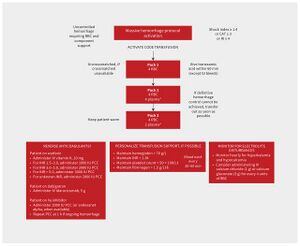Massive hemorrhage protocol
| Massive hemorrhage protocol | |
|---|---|
| Other names: Massive transfusion protocol (MTP) | |
 | |
| Algorithm for a generic massive hemorrhage protocol[1] | |
| Specialty | Emergency medicine |
| Indications | Massive bleeding[2] |
Massive hemorrhage protocol (MHP), also known as massive transfusion protocol (MTP), is a technique used to treat people who have significant and ongoing bleeding.[2] Such bleeding may occur during trauma or during pregnancy.[2]
Aspects of management include identification of bleeding, getting and giving blood products, and stopping bleeding.[2] Blood pressure may be allowed to remain relatively low in those without a head injury.[1]
Definition
A massive transfusion may be defined as more than 3 units of packed red blood cells (PRBCs) in an hour.[2] Other definition include more than half a persons blood volume in 4 hours; more than one blood volume in 24 hours; and more than 10 units of packed red blood cells in 24 hours.[2]
Medical use
A shock index (heart rate divided by systolic blood pressure) of greater than one after a person has been given 1 L of intravenous fluid is useful in determining who may need a MHP.[2]
Technique
Blood products
Blood products may be given as 1 unit of PRBCs, 1 unit of fresh frozen plasma (FFP), 1 unit of platelets.[3] Others give 2 units of PRBCs to 1 unit of FFP and 1 unit of platelets.[1] After the first 30 to 60 minutes, which blood products are used may be based on repeated blood tests.[1] Goals include keep hemoglobin between 80 to 120 g/L, platelets above 50 x 109, and INR under 1.8.[1] In a GI bleed the goal is to keep the hemoglobin above 70 g/L.[1] The patients blood values may be checked every hour.[1]
Medications
Tranexamic acid 1 to 2 gram is recommended within three hours of injury or bleeding after delivery.[1] A second gram is than given over 8 hours.[3] It has not been found to be useful in gastrointestinal bleeding.[1]
Fibrinogen level should be kept above 1.5 g/L (2.0 g/L after delivery).[2][1] This can be achieved with either fibrinogen concentrate or cryoprecipitate.[2]
Calcium gluconate 3 to 6 grams or calcium chloride 1 to 2 grams is recommended every 4 to 6 units of PRBCs with the goal to keep ionized calcium around 1 to 3 mmol/L.[3][1]
Reversal
For those on anticoagulants reversal is often recommended.[1] For warfarin reversal is with 10 mg of vitamin K intravenously together with 1,000 to 3,000 units of prothrombin complex concentrate (PCC).[1] For dabigatran reversal is with idarucizumab 5 grams.[1] And for a Xa inhibitor reversal is with 2,000 units PCC or andexanet alfa.[1]
Other
Other critical measures include keeping the person warm.[1]
References
- ↑ 1.00 1.01 1.02 1.03 1.04 1.05 1.06 1.07 1.08 1.09 1.10 1.11 1.12 1.13 1.14 1.15 Callum, Jeannie; Evans, Christopher C.D.; Barkun, Alan; Karkouti, Keyvan (5 June 2023). "Nonsurgical management of major hemorrhage". Canadian Medical Association Journal. 195 (22): E773–E781. doi:10.1503/cmaj.221731.
- ↑ 2.0 2.1 2.2 2.3 2.4 2.5 2.6 2.7 2.8 "11". Massive hemorrhage and emergency transfusion. 7 September 2021. Archived from the original on 11 April 2023. Retrieved 2 July 2023.
- ↑ 3.0 3.1 3.2 "Massive Transfusion Protocol (MTP)". EMCrit Project. Archived from the original on 7 March 2023. Retrieved 2 July 2023.
External links
- Alberta MHPs Archived 2023-06-10 at the Wayback Machine